
Fr: Canard chipeau
Ang: Gadwall
All: Schnatterente
Esp: Ánade friso
Ita: Canapiglia
Nd: Krakeend
Sd: snatterand
Photographers:
John Anderson
John Anderson Photo Galleries
Steve Garvie
RAINBIRDER Photo galleries & Flickr Rainbirder
Tom Grey
Tom Grey's Bird Pictures & Tom Grey's Bird Pictures 2
Tom Merigan
Tom Merigan’s Photo Galleries
Otto Plantema
Trips around the world
William Price
PBase-tereksandpiper & Flickr William Price
Nicole Bouglouan
PHOTOGRAPHIC RAMBLE
Text by Nicole Bouglouan
Sources:
HANDBOOK OF THE BIRDS OF THE WORLD vol 1 by Josep del Hoyo-Andrew Elliot-Jordi Sargatal - Lynx Edicions - ISBN: 8487334105
BIRDS OF THE GREAT BASIN – by Fred A. Ryser - Univ of Nevada Pr -ISBN: 0874170796
A GUIDE TO THE BIRDS OF MEXICO AND NORTHERN CENTRAL AMERICA by Steve N. G. Howell, Sophie Webb - Oxford University Press - ISBN: 0198540124
FIELD GUIDE TO THE BIRDS OF NORTH AMERICA - National Geographic Society -ISBN: 0792274512
GUIDE DES CANARDS, DES OIES ET DES CYGNES – de Steve Madge - Delachaux et Niestlé - ISBN: 2603013769
THE COMPLETE BOOK OF BRITISH BIRDS – Written by “Royal Society for the Protection of Birds” experts - Préface de Magnus Magnusson - Michael Cady- Rob Hume Editors - ISBN: 0749509112
THE HANDBOOK OF BIRD IDENTIFICATION FOR EUROPE AND THE WESTERN PALEARCTIC by Mark Beaman, Steve Madge - C. Helm - ISBN: 0713639601
All About Birds (Cornell Lab of Ornithology)
Animal Diversity Web (University of Michigan Museum of Zoology)
Bird Web (Seattle Audubon Society)
Wikipedia, the free encyclopaedia
What Bird-The ultimate Bird Guide (Mitchell Waite)
Gadwall
Mareca strepera
Anseriformes Order – Anatidae Family
INTRODUCTION:
The Gadwall is common and widespread throughout the range in the North Hemisphere. It usually frequents open wetlands with patches of vegetation. It is present in N America and N and C Eurasia where it breeds. It moves S after breeding to spend the winter at lower latitudes. However, the birds living in temperate regions are sedentary.
It feeds on pieces of aquatic plants by dabbling and dipping. It nests on the ground and form small flocks after the breeding season. It is less gregarious than most Anatidae.
The Gadwall is vulnerable to pollution and disturbance, predation and hunting, but currently, the species is not globally threatened.

DESCRIPTION OF THE BIRD:
Biometrics:
Length: 46-58 cm
Wingspan: 84-95 cm
Weight: M: 650-1000 g – F: 550-850 g
The Gadwall male lacks the bright coloration of other ducks, but the soft combination of grey-brown and chestnut makes it unmistakable.
The male in summer is grey-brown with white belly and black rump. The grey mantle, back and flanks are vermiculated black and white. The upper breast is black with scaled pattern, whereas the lower breast is white. In flight we can see a white speculum on the wings, and chestnut and back wing-coverts. The underwing is whitish with greyish flight feathers. The tail is pale greyish with black uppertail and undertail-coverts.
The head is greyish-brown with cinnamon wash on forehead and chin.
The bill is slate-grey. The eyes are dark brown. Legs and webbed feet are yellowish-orange.
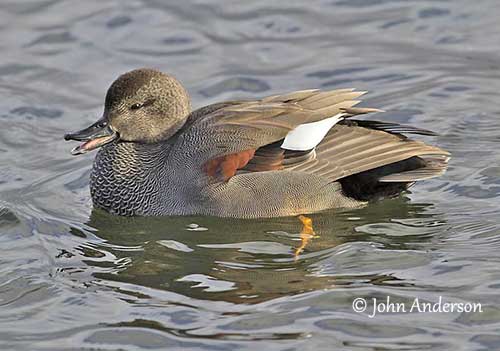
During the non-breeding season, the bill has orange sides and dark culmen. Legs and feet become duller, mostly yellow-olive. It resembles female but with more striking wing pattern.
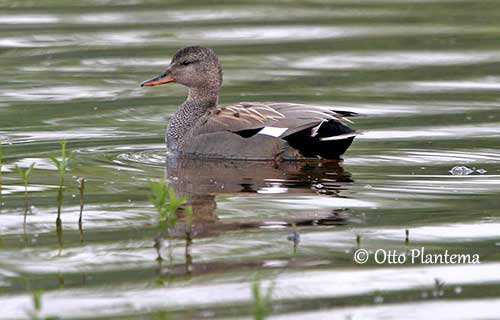
The female has mostly mottled brown and buff appearance and smaller white speculum. Her plumage is heavily scalloped darker, mainly on flanks. Chin and upper breast are paler than in male. The bill is yellowish with dark spots.

The juvenile is darker than female with greyer head and neck, and more streaked than scalloped underparts. The bare parts are duller. The young female sometimes lacks black or chestnut on the upperwing.
RANGE:
The Gadwall breeds in North America from California, N to coasts of Alaska, and locally in the east. It also breeds in N and C Eurasia, from Iceland to N Japan, sporadically in Morocco and Algeria, and also in Turkey and Iran.
It winters often in the same regions, but it also moves S to SC and SE Eurasia, N Africa and SE Asia. The N American populations winter in C North America and Mexico. Small numbers may reach Cuba and other islands in the West Indies.
The race A.s. couesi from Teraina in Line Islands, C Pacific, was discovered in 1874 and is considered extinct.
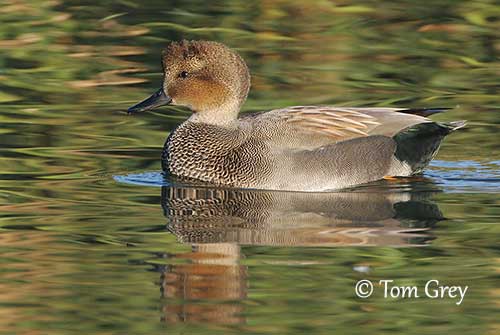
HABITAT:
The Gadwall breeds near lowland freshwater ponds, lakes and marshes with extensive fringing vegetation and plenty of emergent plants. This environment is used to conceal the nest-site, to feed among and take cover in.
During migration and in winter, it occurs in both fresh and salt water marshes, well-vegetated waters, ponds and streams, and locally in estuaries. In Japan and Korea, it is regularly found in ricefields.
During the autumn migration, this species is sometimes recorded at 4700 metres of elevation in the Himalayas of Ladakh.

CALLS AND SONGS: SOUNDS BY XENO-CANTO
The Gadwall is usually relatively silent outside breeding season. But while displaying, the male produces a short “check” combined with a low whistle. It also gives loud, deep croaking “raahk rrahk…”, raucous calls and grunting sounds.
The female gives chattering calls and quacking calls, and produces a repeated “gag-ag-ag-ag-ag-ag”.
BEHAVIOUR IN THE WILD:
The Gadwall feeds primarily on aquatic vegetation, aquatic invertebrates and seeds. It takes mainly the plants growing close to the surface.
On land, it forages in fields for grain, or in woodlands for acorns. Its main diet consists of leaves and stems of aquatic plants, supplemented with insects, crustaceans, amphibians, mollusks and fish.
The female feeds on protein and fat rich diet during the laying period.
The Gadwall feeds mainly by head-dipping and upending. On land, it grazes while walking. It may steal food from other species, including ducks and coots.
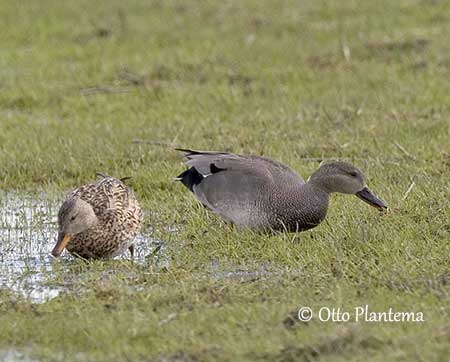
The breeding biology of the Gadwall is interesting, because its nesting success is the highest of all the dabbling ducks. This species is a very late nester, and builds the nest on islands and in tall, dense vegetation. The predators are probably less concentrated on nesting birds late in the season, and less on relatively inaccessible nests.
The Gadwall usually nests from mid-May to mid-July. Each pair has one or more feeding sites (ponds) and two or more pairs often feed in the same area.
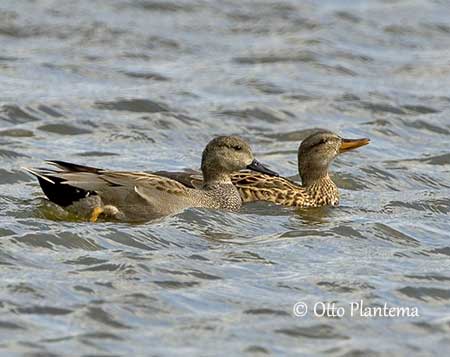
The male has two types of aerial chases. A territorial chase with three birds in flight, during which the male or drake chases the female of an intruding pair and the harrying chase that includes several drakes chasing a nesting female, with the intent of copulating with her. This behavior is called “rape-chases”. Actually, the nesting female is vulnerable because she lacks the protection of her mate, as the male leaves the female early in the nesting cycle.
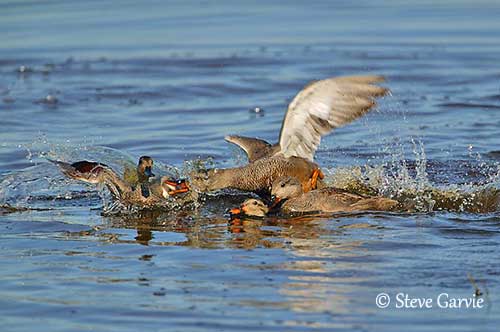
During the courtship displays, the male throws the head far back on shoulders and raises the rear part of the body out of water. The wingtips are lifted to display the white wing patches. This display is called “head-up, tail-up”.
Prior to copulation, both mates bob their heads up and down and touch their bills to the water with necks extended horizontally. When the female extends her neck, the drake mounts her. After the copulation, they bathe in front of each other, the female first and then the male. They are monogamous and the pair-bonds are renewed each year.
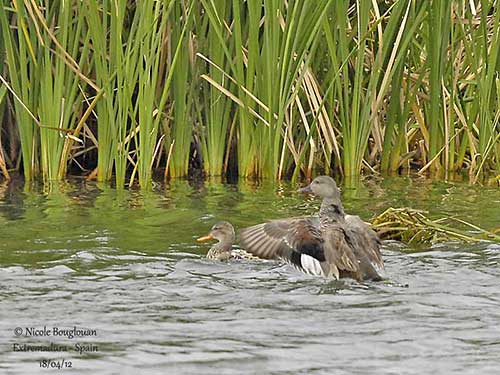
The Gadwall is migratory and leaves the breeding grounds in N in September. They migrate by night, in flocks of less than 100 individuals, but large numbers migrate in separate groups and reach the same destination within hours of each other. The breeders of southern regions are mostly sedentary, and moves only for moulting, sometimes flying up to 250 kilometres from their breeding areas.
The Gadwall has fast, direct flight with rapid wingbeats.
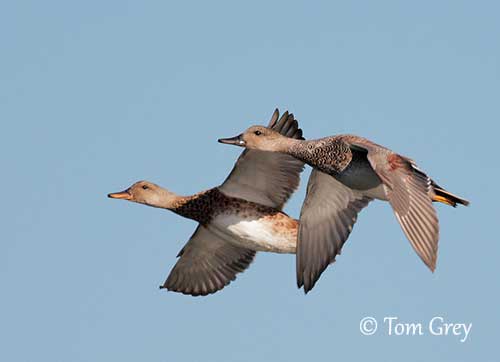
REPRODUCTION OF THIS SPECIES:
The breeding season starts in April/May and lasts until July. The nest-site is usually chosen by the female, often near her natal area. While she searches for suitable site or nest materials, the male stand guards. Then, she builds the nest by scraping a depression in the soil. This bowl-shaped nest is lined with leaves, grasses and twigs found in the vicinity of the nest. And finally, she plucks down feathers from her body and adds them to the lining. The nest is well-hidden among the dense vegetation.
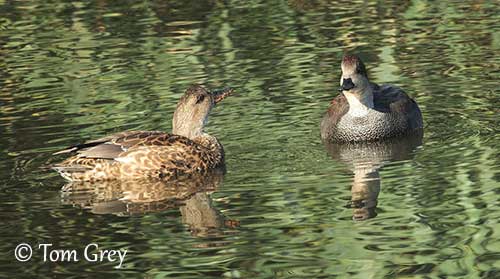
The female lays 7-13 creamy-white eggs at the rate of one egg per day. However, two or more females may lay in the same nest.
She incubates alone during 24-27 days. The chicks are precocial and leave the nest very soon after hatching. They have pale brownish down above and creamy-buff below. The female leads them to the water where they are able to feed themselves. They usually frequent fairly open water. The young perform their first flight between 48 and 59 days after hatching.
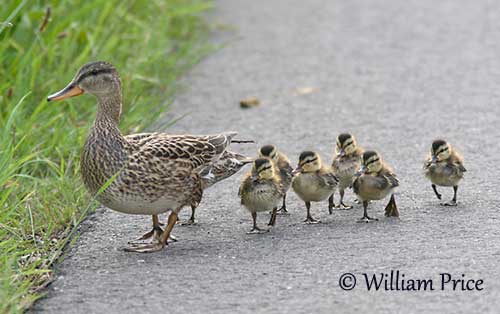
PROTECTION / THREATS / STATUS:
The Gadwall is threatened by pollution and disturbance on freshwater wetlands, due to recreational use. It also suffers nest predation by American mink (Neovison vison) and hunting pressure throughout most of the range. The eggs are harvested in Iceland.
The global population is estimated to number 3,200,000/3,800,000 individuals (2006). The overall population trend is uncertain, with some decreasing populations while others are stable or increasing or have unknown trend.
The Gadwall is currently evaluated as Least Concern.